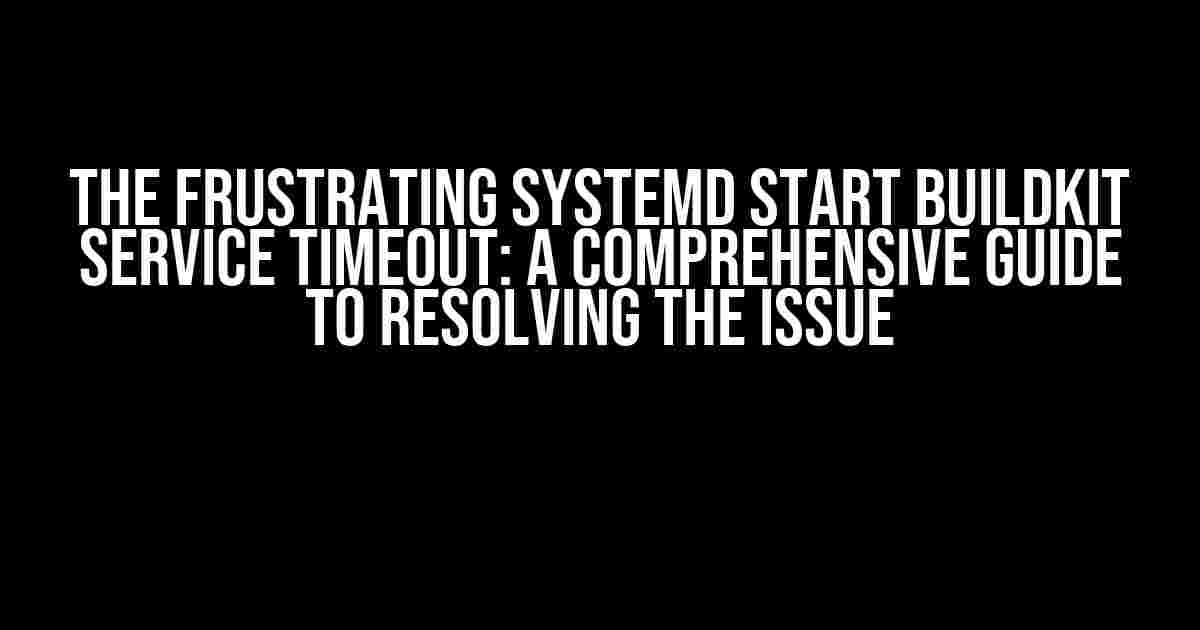Are you tired of dealing with the systemd start BuildKit service timeout issue? You’re not alone! Many developers and system administrators have encountered this frustrating problem, wondering why their BuildKit service just won’t start. In this article, we’ll dive into the world of systemd, BuildKit, and Docker, explaining the reasons behind the timeout and providing step-by-step instructions to resolve the issue once and for all.
What is systemd and How Does it Affect BuildKit?
systemd is a system and service manager for Linux operating systems. It’s responsible for managing system resources, services, and daemons, ensuring they start and stop correctly. BuildKit, on the other hand, is a build service that enables fast and efficient building of Docker images. When you try to start the BuildKit service using systemd, you might encounter the timeout error.
Why Does the systemd Start BuildKit Service Timeout Occur?
There are several reasons why the systemd start BuildKit service timeout occurs:
- Dependent Services Not Started**: BuildKit relies on other services, such as Docker, to function correctly. If these dependent services aren’t started or aren’t functioning properly, BuildKit won’t start.
- Incorrect Configuration**: Misconfigured BuildKit or systemd settings can cause the timeout error. This might be due to incorrect file paths, permissions, or syntax mistakes.
- Resource Constraints**: BuildKit requires sufficient system resources, such as CPU, memory, and disk space, to function correctly. Insufficient resources can cause the timeout error.
Troubleshooting and Resolving the systemd Start BuildKit Service Timeout
To resolve the systemd start BuildKit service timeout, follow these step-by-step instructions:
Step 1: Verify Dependent Services are Started
Ensure that all dependent services, such as Docker, are started and functioning correctly. You can check the service status using the following command:
systemctl status dockerIf the service is not started, start it using:
systemctl start dockerStep 2: Check BuildKit Configuration
Verify that the BuildKit configuration is correct. Check the following:
- BuildKit configuration file: Ensure the file is correctly formatted and contains the correct settings. You can find the configuration file at
/etc/buildkit/config.toml. - File permissions: Verify that the BuildKit configuration file has the correct permissions. Run the following command to check permissions:
stat /etc/buildkit/config.toml - Service file: Check the BuildKit service file (e.g.,
/etc/systemd/system/buildkit.service) for any syntax errors or incorrect settings.
Step 3: Inspect systemd Logs
Check the systemd logs to identify the cause of the timeout error. You can view the logs using:
journalctl -u buildkitAnalyze the log output to identify any error messages or clues that might indicate the cause of the timeout.
Step 4: Increase systemd Timeout Value
In some cases, increasing the systemd timeout value can resolve the issue. You can do this by creating a drop-in configuration file for the BuildKit service:
mkdir /etc/systemd/system/buildkit.service.d
echo "[Service]" > /etc/systemd/system/buildkit.service.d/override.conf
echo "TimeoutStartSec=300" >> /etc/systemd/system/buildkit.service.d/override.conf
systemctl daemon-reload
systemctl restart buildkit
This increases the timeout value to 300 seconds. You can adjust this value based on your system’s requirements.
Step 5: Disable systemd’s built-in timeout
If increasing the timeout value doesn’t resolve the issue, you can try disabling systemd’s built-in timeout mechanism:
mkdir /etc/systemd/system/buildkit.service.d
echo "[Service]" > /etc/systemd/system/buildkit.service.d/override.conf
echo "TimeoutStartSec=0" >> /etc/systemd/system/buildkit.service.d/override.conf
systemctl daemon-reload
systemctl restart buildkit
This sets the timeout value to 0, effectively disabling the built-in timeout mechanism.
Additional Troubleshooting Steps
If the above steps don’t resolve the issue, try the following:
Verify Resource Availability
Ensure that your system has sufficient resources, such as CPU, memory, and disk space, to run the BuildKit service:
free -h
df -h
If resource constraints are the issue, consider upgrading your system or optimizing your BuildKit configuration to reduce resource usage.
Check BuildKit Version
Verify that you’re running the latest version of BuildKit:
buildkit --versionIf you’re not running the latest version, consider upgrading to the latest release.
Systemd Configuration
Verify that your systemd configuration is correct. Check the following:
- systemd version: Ensure you’re running a compatible version of systemd.
- systemd configuration files: Verify that the systemd configuration files are correctly formatted and contain the correct settings.
Conclusion
The systemd start BuildKit service timeout error can be frustrating, but with the right approach, you can resolve the issue and get your BuildKit service up and running. By following the steps outlined in this article, you’ll be able to identify and fix the underlying causes of the timeout error. Remember to verify dependent services, check BuildKit configuration, inspect systemd logs, and adjust systemd timeout values or disable the built-in timeout mechanism if necessary.
| Troubleshooting Step | Description |
|---|---|
| Step 1: Verify Dependent Services | Ensure dependent services, such as Docker, are started and functioning correctly. |
| Step 2: Check BuildKit Configuration | Verify the BuildKit configuration file and service file for correctness and syntax errors. |
| Step 3: Inspect systemd Logs | Analyze systemd logs to identify the cause of the timeout error. |
| Step 4: Increase systemd Timeout Value | Increase the systemd timeout value to allow more time for the BuildKit service to start. |
| Step 5: Disable systemd’s built-in timeout | Disable systemd’s built-in timeout mechanism to allow the BuildKit service to start without timeouts. |
By following these steps and troubleshooting your system, you’ll be able to resolve the systemd start BuildKit service timeout error and get your BuildKit service running smoothly.
Frequently Asked Questions
Get answers to the most commonly asked questions about “systemd start the buildkit service always timeout”!
Q1: What is the main reason behind the systemd timeout issue with the buildkit service?
The primary culprit behind this frustrating issue is usually a misconfigured or overly restrictive timeout value in the systemd service file. This prevents the buildkit service from starting within the allotted time frame, resulting in a timeout error.
Q2: How do I increase the timeout value for the buildkit service in systemd?
To increase the timeout value, you’ll need to edit the buildkit service file (usually located at /etc/systemd/system/buildkit.service) and modify the TimeoutStartSec parameter. For example, you can set it to 300 seconds (5 minutes) by adding the following line: TimeoutStartSec=300. Don’t forget to reload the systemd daemon and restart the buildkit service after making changes!
Q3: Can I disable the timeout entirely for the buildkit service?
Yes, you can disable the timeout by setting TimeoutStartSec to 0. However, this is not recommended as it may lead to unintended consequences, such as the buildkit service hanging indefinitely. It’s usually better to set a reasonable timeout value that allows the service to start normally.
Q4: Are there any other common issues that can cause the buildkit service to timeout with systemd?
Yes, other common culprits include insufficient system resources, malformed Docker configuration files, and network connectivity issues. Make sure to check the system logs for any error messages related to these potential causes and troubleshoot accordingly.
Q5: What if I’ve tried increasing the timeout and troubleshooting other issues, but the buildkit service still won’t start?
In this case, it may be worthwhile to seek assistance from the buildkit community or a professional system administrator. They can help you debug the issue and provide personalized guidance to get the buildkit service up and running smoothly.


